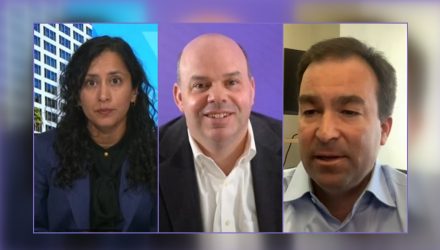Perhaps no macroeconomic storyline looms over U.S. investors this year as much as the rate cut drama does. The Fed’s “will they, won’t they” narrative about cuts is a very different story than investors saw entering 2024 when several cuts looked almost baked in. Now, investors have to adapt, with fixed income an important piece of that puzzle, as discussed during the recent VettaFi Fixed Income Symposium.
Panel Discussion
The session included a panel, “Outlook on Interest Rates: How to Position Fixed Income Portfolios,” which spoke to the rate cut discourse and its impact on fixed income allocations. Hosted by VettaFi head of research Todd Rosenbluth, the panel included T. Rowe Price portfolio manager Alex Obaza and PIMCO managing director and portfolio manager Sonali Pier.
Both managers pointed to inflation data as a key metric for consideration, given how much the Fed hones in on it.
“The inflation picture is really where a lot of the focus has been, as we try to predict how many cuts are potentially in the back half of the year or even, could we be surprised with none?” Pier said.
See more: Attractive Yields But Narrow Spreads: The Credit Dilemma
T. Rowe Price’s Obaza pointed to a discrepancy between the Fed’s cyclical monetary tools and the structural nature of the inflation. Domestic spending, whether COVID relief money or big legislation like the Inflation Reduction and Chips Acts, has somewhat offset the Fed’s tightening regime.
“I would say maybe one cut this year, if you forced me to put a number on it,” Obaza said. “I think the main point, as opposed to exactly when or how many cuts we get this year, is at the cutting cycle. Whenever it starts, is not going to mirror the hiking cycle we had in 2021 and 2022.”
One-fourth of poll respondents during the segment shared that they believe the Fed will not cut in 2024. About three-quarters of respondents, by contrast, shared that they expect one to two rate cuts.
Obaza pointed to a few areas that stand out in fixed income this year, given the rate environment. He underlined the one-to-three-year part of U.S. dollar-denominated fixed income. AAA CLOs and certain asset-backed security markets in autos and equipment also appeal, he said. Pier added that residential mortgages and agency mortgages, on top of securitized credit, also appeal.
Fixed Income ETFs
Each firm offers a variety of fixed income ETFs. For T. Rowe Price, the T. Rowe Price Ultra Short-Term Bond ETF (TBUX), which will hit its three-year ETF milestone this Fall and is managed by Obaza, could appeal. charging only 17 basis points (bps), which is very competitively priced for an active ETF, it has returned 6.6% over one year. He emphasized that active ETFs like TBUX have certain strengths that passive fixed income strategies do not.
“It’s really hard to do passive in fixed income the way you do in equity,” he said. “Bond indices are larger, have inferior liquidity, and sometimes, honestly, it’s just hard to buy all the bonds that are in an index.”
TBUX seeks a high level of income by targeting an effective duration of 1.5 years or less. It looks for mortgage-backed securities, municipal bonds, bank obligations, and more while overweighting short-duration offerings.
For PIMCO, the firm offers ETFs like PYLD, the Multisector Bond Active ETF. PYLD, which charges 55 basis points (bps), actively invests in U.S. and non-U.S. bonds.
For more news, information, and analysis, visit the Active ETF Channel.








